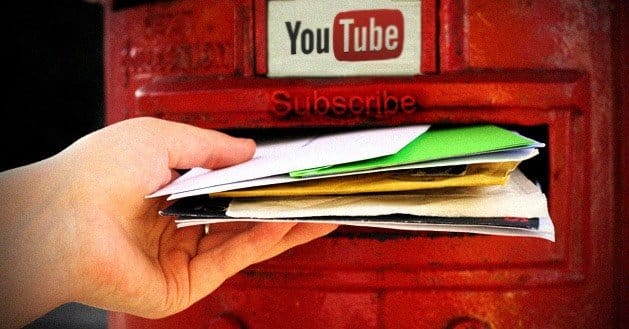 Written by ContentPowered.com
Written by ContentPowered.comEveryone who has uploaded a video to YouTube knows this scenario. Your videos receive hundreds or thousands of views, but your subscriber list hovers close to zero. Yet the goal of marketing on YouTube is to gather subscribers who are interested in your content. Subscribers are a guaranteed audience; without them, every time you post a video you have to market it from scratch. What can you do to convert your viewers into subscribers?
#1: Ask!
Asking your viewers to click the subscribe button is the easiest way to gather more subscribers. How do you ask? Add a call to action to the end of your video. You’ve probably seen these on popular videos you’ve watched. When the video content ends, you’re presented with ten or so seconds of the video creator asking you to like and subscribe, typically with a box that links to another video and an arrow that points to the subscribe button.
Building an effective end-of-video call to action is as simple as What, How and Why. Tell them what to do; namely, like the video and subscribe to the channel. Tell them how, by directing them to the buttons on the video interface. Finally, tell them why; if they liked the video, if they want more content from your channel, etc. All you need is a brief speech, something like “If you liked this video and want to see more by <company name>, make sure you subscribe to our channel by clicking the button.”
#2: Utilize Annotations
Annotations are a form of link overlaid on top of a video as it plays, during specific points as controlled by the timestamp. You can use them as simple messages that tell viewers about updated information in the video. You can use them, carefully positioned, to point to the like and subscribe buttons. You can also use them at the end of the video in your call to action, as a link directly to your subscription page. Combined with a graphic in the video itself, it creates an interactive button that takes users directly to the subscription portion of the site, without forcing them to navigate on their own.
Annotations are a powerful tool, but they should be used sparingly. Avoid screen-covering annotations unless you absolutely need to update the information on a full-page slide on an old video. Use them infrequently, and primarily for call to action links. The more you use them, the more likely it is that users will turn them off completely.
#3: Customize your Advertising
When you activate monetization through YouTube, a small sponsored ad appears at the bottom of the video, typically during the first few seconds. These ads, by default, display whatever YouTube wants them to display. With a bit of a workaround, you can change what the ad displays to customize it for your channel.
- First, you need a Google Adwords account. If you already have one, perfect. If not, all you need is a short ad campaign, as little as a $1/1 day ad. You need to create a “display ad” using the YouTube Promoted Videos template.
- Second, visit YouTube and click the edit video button. You’ll find a new menu, the Call to Action Overlay. You can customize this overlay to link to your subscriber page, your website or any other destination you want to promote.
This method has a few benefits and one major drawback. The benefits are obvious; you can control the content of the ad on your video. You only need to make the Adwords investment once to activate the option and it works indefinitely. There’s no guarantee YouTube won’t close off the option eventually, but for now it’s a nice workaround. The drawback is simple; since you’re customizing the content of the ad, the ad no longer monetizes your video. If you think you’d earn more from YouTube’s sponsored ads than you would from building subscribers, it might be better to avoid this technique.
#4: Optimize your Videos
SEO applies to YouTube as much as any other website. You need to consider the keyword applications of your video title and description. In fact, you can even benefit from optimizing your channel page and channel name, as well. It’s a basic tip, but it’s one that too many channel owners forget.
Avoid the spam tactics used in some of the more awful videos, including filling the usually-hidden description field with keyword lists. These do nothing to help your video and can earn you a penalty.
#5: Make your Content Worth Viewing
It make seem obvious, but if you want to earn viewers and subscribers, you need to provide content worth watching. Consider it in the same light as a blog post; if you want more readers, you need to give them something to read.
In general, this means making your videos interesting and unique. Something related to your niche, current events and thought-provoking analysis is best. You should also make sure you post videos relatively frequently. More videos means more opportunities for viewers to subscribe to something they like.
#6: Off-Site Promotion
Obviously, you should promote your videos elsewhere. Consider integrating a YouTube widget into your website, in addition to the usual shares through your blog, Facebook, Google+ and Twitter accounts.
Installing the YouTube subscription widget is incredibly easy. All you need to do is paste in the code provided by YouTube, including your username. You can find the code on YouTube’s blog, here: http://youtubecreator.blogspot.com/2013/07/drive-youtube-subscriptions-from-your.html
You can also contact related YouTube channel owners and ask about featured channel promotions. These are where a content creator links to your channel in their featured channels box, directing their traffic to check out your content. Typically these recommendations will be mutual, and beneficial to both parties.
#7: Remember YouTube is Social Media
YouTube has a reputation around the web as a haven for some of the worst people ever to post a comment on a piece of content. Really, on popular videos and videos in certain content areas, the quality of the average YouTube comment really is dreadful. Monkeys with typewriters could create comments with better grammar and fewer insults.
Depending on your niche, however, you may very well encounter none of this. YouTube’s recent changes to the algorithm that shows comments, as well as integration with Google+, further discourages the worst of the worst. Today, comments are a relatively sane place to visit.
Take advantage of the social aspects of YouTube to chat with and engage the users who comment on your video. Whether it’s a simple thank you, answers to a question or encouragement of some kind, commenting on comments helps users engage with your brand. This engagement further leads to subscriptions, more views and a wider audience.
#8: Provide an Incentive
Contests work on Facebook, why not YouTube? Set up some form of incentive to encourage users to subscribe. Announce your current follower count and your goal, typically a reasonable number above your current level. Then, pick something to do when you reach that count. Will you provide more content regularly? Will you post a special video? Will you give away a product to a lucky subscriber once you reach your goal? Whatever you choose, you can promote this sort of contest on your other social media channels for further benefit. You’ll bring in the subscribers in no time.



Thanks that a great tip to get youtube subscribers!
Thanks that a great tip to get youtube subscribers!